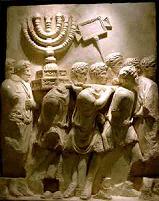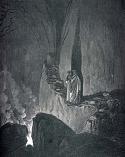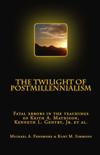A Critical Response to Kurt Simmons' Bi-Millennialism
by
Samuel Frost
Simmons/Frost Debate
Editor's Note: Following is an article written by Sam Frost offering a critical analysis of Bimillennial Preterism, followed by my response. Mr. Frost wrote his article in response to my article against Max King's approach to "the" millennium of Revelation twenty. The reader should first reader my article against King ( click here - Transmillenarianism), then precede to Frost's article (below), and finally, my response (click here - Simmons).
Readers of Preterist theology should not mind the exchange of
critical assessments of particular ‘new submissions’ to this field.
I am glad to see that Mr. Simmons is offering an alternative
approach; working with the text and interacting with other views in
order to further clarify Preterist exegesis. Mr. Simmons, from all
accounts, is a Preterist and his eschatological framework locates
the ‘end of all things’ squarely within the C.E. 66-70 period.
As I have stated before in my assessments of others’ positions within Preterism [1] one should not be dismayed that we have entered into a historical era of Preterism never before seen. Since this is the case, new ideas are going to be set forth, some good, some extremely bad. Some will last the test of time and exegesis, others will be exposed merely as novel attempts to force a particular issue. This will, in turn, generate a polarization within Preterism itself, such as the Immortal Body Now/Immortal Body at Death camps; Anti-Church/Church camps;
Universalists/Particularists camps, and the like. Of course, one could just throw up their hands and say, “None of this matters at all.” Well, then, neither does the view that ‘none of this matters at all,’ which itself is a position to be accepted or rejected on the basis of critical analysis.
I read Mr. Simmon’s article from the Preterist Archives.com site, and here on Planet Preterist. I thumbed through his book being sold at John Anderson’s conference on Revelation and heard much praise ‘for certain parts’ and a little skepticism towards other parts, mainly, Simmons claim to have solved the ‘millennial problem.’ As my response to the Kloske brothers’ book (The Second Coming) showed, I maintained the position that King took, by and large, for I Corinthians 15 over and against what I saw as a mistaken exegesis on their part. I do the same here, concluding at this point that Mr. Simmons has not really ‘solved’ any problem and that the insistence of ‘two millennia’ being represented in Re 20 is, simply, mistaken. Be that at it is in my opinion, I applaud Mr. Simmons’ efforts and his integrity to put forth a view that keeps well within the Preterist framework (a framework we all appear to agree with). I also applauded the Kloske brothers and their work. It generates serious discussion and analysis of various texts while seeking to maintain the biblical framework that the ‘end of all things’ culminated within the destruction of Israel ‘according to the flesh’ in 66-70 C.E, and that can’t be bad at all for this movement. Stagnation will be the death of Preterism, but theological debate and critical endeavors boldly asking questions within this framework will only seek to stir up solutions and further illumination for those involved. Thus, I view what Mr. Simmons has done as good, even though I think is argument is somewhat weak.
Because I agree with the framework Simmons operates in, we can agree on a great deal of material. In order to keep this paper as brief as possible, it is assumed that the 70 C.E. position is correct to assert that the Second Coming, Resurrection, and Judgment (the scene of Re 20.11-15) occurred then. Simmons also agrees that the scene of ‘Gog and Magog’ is the great end-time battle centered within the historical occurrence of the Jewish War. This is the ‘little time’ ’42 months’ ‘short time’ and the like. John wrote down his visions before this ‘little time’ occurred and therefore the ‘time’ that was ‘at hand’ was ‘shortly’ to take place. That this is proven can be seen by appealing to Re 17.8 ‘The beast, which you saw, was, and is not, and is about to come out of the abyss (mellei anabainein ek tes abussou).’ This, again, is shown in 17.11, ‘and the beast which was and is not.’ Re 20.2,3 notes that the ‘dragon’ is ‘thrown into the abyss’ for a thousand years and will, after the thousand years are ended, come up out of the abyss to lead the Gog and Magog hordes to ‘encircle’ the ‘beloved City’ (20.9). The point is clear, exegetically: John is writing in the time when the beast/dragon is not because he is bound, but he was about to come up out of the abyss and destroy the woman, the Great City, the Beloved City, the Holy City (11.2), or Jerusalem. In 11.2 Jerusalem is called by its covenantal name, the Holy City, and the ‘beast, the one coming up out of the abyss’ will persecute the ‘two-witnesses’ within her walls (11.7). Therefore, the Holy City, the Beloved City and the Great City are all the same covenantal references for Jerusalem of the old covenant, for within the old covenant, God had set his affections upon that city, and since the old covenant had yet to entirely ‘vanish’ (Hebr 8.13), the Apostate City can be called both ‘Sodom’ on one hand (11.8) and ‘holy’ (11.2) on the other. This can be demonstrated amply enough in the Hebrew Scriptures. The point is, Re 11 and 20.7-10 are picturing the same events: the Holy, Beloved City will be destroyed by the beast/dragon that ‘is about to come out of the abyss.’
Simmons goes into an amazing search for the historical referents of these events, locating them in such detail that it causes one caution just reading it. For me, it matters not. Biblical prophecy often exaggerates what actually would historically occur. Apocalyptic language (a poor designation, but one that I will use nonetheless) often employs hyperbole. The symbolism is the important point, and while there are historical referents, it is not necessary at all to locate each and every detail of the symbolic drama in historical detail of the times it portrays. Such attempts have all met with failure, and contain their own problems. The point of John’s visions is to symbolically portray what God was doing in the heavenlies, only loosely pointing to historical events (sometimes with great precision, sometimes not). Nero’s persecution of Christians, for example, was not an empire wide persecution, nor was it ever an officially issued persecution. Nero’s persecution gave permission for others within the empire to look down upon Christians, and Christians were persecuted locally by Rome-loyal cults, but if Re 13 describes the persecution of Nero against the saints, the description hardly fits every detail of history. Opponents of Preterism often point this out in an attempt to show our position as false, but, knowing the function of hyperbole with prophetic symbolism, one need not succumb to a false interpretation of symbols that demands a ‘tit-for-tat’ correlation of every symbol with a historical referent. Thus, the question, ‘when did the Lord split the Mount of Olives in two as Zech 14 says?’ is a moot question that assumes a ‘tit-for-tat’ correlation in history. The Mount of Olives never split into two, and Zech 14 is fulfilled. The examples of this are countless.
Now, Simmons claims that any reading but his own necessarily leads to ‘futurism.’ I am not sure how this is, since he never really explains how it does. For me, the ‘single millennium model,’ offers no real problem. Nonetheless, let us look at a few points offered against King’s view and see if, in fact, they demand a necessary capitulation to Simmons own understanding.
First off, he notes that the persecution under Nero must be the referent to Re 20.4. This leads me to conclude, if I were a novice, to think that persecution did not happen at all before Nero. However, we know from the testimony of history and the Bible that both the Jews and Rome persecuted before then. What is often missed is that when Rome expelled the Jews under Claudius, Christian Jews were also included, since Rome, before C.E. 70, made no distinctions between Christianity and Judaism. Christianity was merely another sect within Judaism. We read this in Acts 18 that under the expulsion of Claudius, many Jewish Christians, such as Priscilla and Aquilas were under the ban as well and settled in Corinth. Thus, the saints stands for both Jews and Gentiles, but from the perspective that when Rome cracked down on Jews, Jewish Christians were often thrown into the same lot.
The reason I make this observation is the issue with 20.4, ‘And I saw thrones and they sat upon them and the authority to judge was given to them. And I saw the persons (souls – psyche) of those having been beheaded because of the witness of Jesus and for the word of God, and whoever did not pay homage to the beast, nor his icon, and did not take the mark upon the forehead and upon their hand. And they did live and reigned with the Messiah for the thousand years’ (translation mine).
Several points need to be made here. First, only one group is mentioned: those who were given authority to judge (krima). Within this group are those who have been beheaded. All sat on thrones, whether beheaded or not. That the syntax of the Greek supports this idea is quite feasible. The question is, when were these given authority to judge? It must be when they came to life (both are aorist aspects). Thus, when they came to life, they were given thrones and authority to judge, being that they were ‘with Christ.’ This is closely akin to ‘being seated with Him in heavenly places.’ It is this that John is picturing here. When did any ‘come to life’ in Christ? When they received the Holy Spirit and came into what Paul calls, ‘newness of life’ (Ro 6.11,13 where the same verb is used).
Simmons objects to this view on the basis that these souls (persons) are beheaded only under Nero, which represents the beast coming up out the abyss after the thousand years are ended. Yet, persecution, as I have mentioned, was before Nero. Nero is merely one head of the beast, and John does not mention any single head here. He just mentions ‘the beast.’ Secondly, it is assumed that ‘the beast’ must always represent Nero, since, in the time of John’s writing, Nero was the emperor, and six hundred and sixty-six refers to his name. But, clearly, one head (Nero, the fifth head – 17.10) represented currently the ‘beast.’ But, Claudius, another head, represented the beast as well. Tiberius, when he was emperor, was ‘the beast.’ To single out that one head alone means ‘beast’ misses the fact that the ‘beast’ has seven heads/emperors. Whoever was currently ruling in power as Emperor was the beast. Certainly, Nero was not the only one that demanded homage to his icons! Augustus, Tiberius, Caligula and Claudius were ‘worshipped’ as well by the local emperor cults. Thirdly, as Re 17 has already shown, when you think of ‘the beast’ you are also to think of the ‘woman who rides on the beast.’ The ‘woman who rides on the beast’ enjoyed this status before the beast turns against her and burns her up (the ‘little time’ after the ‘thousand years’ – 17.16-18). Thus, not paying homage to the beast equally means not paying homage to the woman who, for a time before she is burned, rides on the beast. For John, before the burning of the woman, when you think of ‘the beast,’ think also of the Whore that rides on him.
Thus, it is not necessary to think that the ‘beheading’ here must take place only under Nero, or the receiving of the mark of the beast must only refer to Nero’s mark. Every emperor represented the beast while in power, and, therefore, demanded allegiance (taking the mark, symbolically). Apostate Judaism enforced allegiance to Rome as John later stated: “We have no king but Caesar!” Those who did not bow to this evil alliance are those who, rather, received the ‘mark’ of the Spirit of Life, having been raised ‘with Christ’ and ‘seated in heavenly places.’ Some of them would eventually be beheaded on account of their witness for Jesus, but all of them, that is, all saints, were given authority to judge and reign and rule with Christ. It is because they first came to life that their position in Christ remained in the status as ‘souls’ seated on thrones after they were killed that John is asserting here. They did not come to life after they were beheaded. Rather, they came to life and were given a throne. Then, some of them were beheaded, but this hardly means that their throne-privileges were taken away. Their souls are still accounted the same throne-privilege status they had before they were beheaded.
Again, if John is writing from the perspective of the beast getting ready to ascend out of the Abyss, which I maintain he was, then why does he used the perfect tense for those who have been beheaded? The perfect tense denotes the state of action in the past, with present effects. Thus, if John is saying that, from his perspective, some have already been beheaded, and the beheading takes place under Nero, which marks the time after the ‘thousand years’ then John is not anticipating the beast to come up out of the abyss. Rather, the beast has already come up out of the abyss and John is writing not during the Millennium, but after! Post-Millennialism indeed! But, no one suggests this, and I do not believe Mr. Simmons does, either. John was indeed writing during the thousand years [2]. From John’s perspective, then, the beast has yet to come up out of the abyss, but, some Christians have already been beheaded for the faith, and all the saints reign with God, regardless.
John further describes them as those who ‘will will made priests of God and of Messiah and will reign with Him for the thousand years’ (20.6). Yet, in 1.6 being made ‘priests’ and ‘kings’ is a thing already in progress. Surely ‘kings’ reign on ‘thrones’! How is one made to sit with Christ in heavenly places? Does he not have to first ‘die’ in order to be ‘made alive’ (‘come to life’) by the Spirit? 5.10 states, ‘he has made them kings and priests and they will reign upon the earth.’ Is this ‘reign’ any different from the ‘reign’ contemplated in 20.4,6? Hardly. All saints reigned upon the earth and were seated in heavenly places with Christ, having been given thrones, being made kings. Those who were martyred during the transition period are specifically singled out only to denote that their souls continued crying out under the alter and that their rule and reign as priests of God was still a status that belonged to them. But, to single out martyrs as if receiving any more special treatment from God from anyone who had faith in Jesus, but was not martyred is the stuff of the second century martyr cults, not biblical theology. It appears that Simmons is doing just that. Martyrs are no more ‘saved’ or given ‘special status’ than any saint of God. Roman Catholicism teaches such things, but not the Bible.
Thus, having disposed with the contention that those who ‘come to life’ must be only the ‘martyrs’ I can move on to consider another contention of Simmons. I cannot deal with all of them, and I am sure that a response will, hopefully, be written of this paper.
The contention that John has in view ‘two millennia’ is supposedly supported by appealing to the anarthrous use of the adjective-noun phrase (‘thousand years’) and the articulate use of the same. That is, in the Greek text, ‘the’ occurs before ‘thousand years’ in 20.3,5,7 and without the article in 20.2,4,6 [3]. John’s first use is anarthrous (without the article), but the second is articulate. His third is anarthrous, but the fourth is articulate. The fifth is anarthrous, but the sixth and final use is articulate. Thus, plainly, he is going back and forth between the articles, clearly telling us that these are the same periods of time envisioned. The Greek articles that occurs in the second instance (20.3) refers back to the inarticulate phrase in 20.2, and is, thus, anaphoric as Greek articles often are. In Greek, it is not at all necessary to continue the use of articles if anywhere in the immediate context an article is used. Thus, in Greek, one can write, “get bread and water” and later, “did you get the bread and the water like I asked?” The article in the second sentence refers back to the inarticulate ‘bread and water.’ Simmons is under the impression, citing no grammar on Greek, that just because ‘the thousand years’ is used and ‘thousand years’ (without ‘the’) is used also, then two thousand year periods are envisioned here. But, there is no support for this whatsoever either here, or in any grammar. Clearly, by John’s rhetorical device, a chiasm of sorts is being used:
A – ‘thousand years’ (20.2)
B – ‘the thousand years’ (20.3)
C – ‘thousand years’ (20.4)
D – ‘the thousand years’ (20.5)
E – ‘thousand years’ (20.6)
F – ‘the thousand years’ (20.7)
Each are used three times in interchange for one another, beginning with the indefinite use and ending with the definite. There is no suggestion whatsoever that a ‘bi-millennial’ scheme is in view here.
Secondly, A refers to the period of binding, but F refers to the period after the binding. If ‘thousand years’ is different from ‘the thousand years’ then John needs to clear this matter up, because he uses the article and the lack of the article for the binding period! Thirdly, Simmons notes that in 20.2 ‘satan’ ‘devil’ and ‘dragon’ are, quote, “not proper names.” This is patently false. In 20.2 ‘satan,’ is used with the article, as well as in 20.7. The nominative noun used with an article in Greek denotes a proper name, as in ‘ho theos’ (the God) or ‘ho Paulos’ (the Paul) or ‘ho Iesous’ (the Jesus). English drops the article because we do not call to someone by ‘the Kurt.’ We just say, ‘Kurt.’ But, Greek is not English, and Greek personifies by the article with a proper noun. In 20.2, ‘devil’ is used without the article, but in 20.10, it is used with the article. On Kurt Simmons grammatical methodology, ‘diabolos’ in 20.2 is not the same as the diabolos in 20.10 since one has the article and the other does not! If Paul uses Iesous (Jesus) without the article and ho Iesous with, then are two Jesus’ envisioned?
Conclusion
Looking at the length of paper I have used already, I simply won’t bore the reader any longer. Regardless of what one says about King’s view (and I do not hold to all that King does in his analysis in Cross and the Parousia on the millennium), the Bi-Millennial approach is not, for me, a viable alternative or solution. It damages the integrity of the Greek text (and no one has ever suggested such a thing as a result who knows their Greek). I do not believe that King offered a Mormon like ‘vicarious’ salvation of the firstfruits, but only a representative view. It was through the body of Christ, the Church, that the ‘rest of the dead’ came in (I Cor 15.35). Simmons, interestingly enough, did not mention John 5.24-29 which envision a resurrection of the ‘dead’ that ‘now is’ and a resurrection of the dead that ‘is coming.’ Given that the same John wrote Revelation, the ‘first resurrection’ is what was ‘now is’ for John, whereas the ‘rest of the dead’ ‘was coming.’
Pastor Samuel Frost Christ Covenant Church, St. Petersburg, FL Eastertide, 2004
[1] By Preterism I mean all forms dealing within the framework mentioned above. In my e-mail exchanges with Keith Mathison, definitions are hard to come by. Thus, Preterism is defined as any attempt to locate the Second Coming, Resurrection, Judgment within the 66-70 C.E. ‘end.’
[2] Some have suggested that since ‘thousand’ here is plural (xilia ete), then it should be ‘thousands’ (plural) instead of ‘thousand.’ This is because such views, never documented, rest on no knowledge of Greek. The noun for ‘years’ is plural and xilia is an adjective. Since a thousand is many years, then ‘years’ is plural and the adjective modifying the noun must agree with the number it modifies. Thus, xilia ete is correctly translated ‘thousand years.’
[3] It is best judged that
the articles does not occur in 20.6. The Greek Text has the article
in brackets with a C rating. The best evidence suggests omitting it.
For rhetorical reasons given above, it will be seen that the
omission is correct on textual grounds as well.
To receive Kurt Simmons’ e-mail newsletter, The Sword & The Plow, click the Subscribe link:
All rights reserved.






